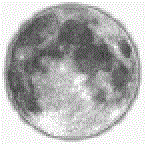
Moon Parable: a Foreword
The Ministry of Apostle Paul
Is the moon, whose natural state is revealed to be darkness, therefore a servant of darkness? Indeed, not; for without passion, in each and every aspect of all her phases, the moon gives true and faithful testimony, not of herself, but of the sun's majesty. A wholly devoted acolyte, the moon is incapable of serving itself; and its eclipse of the sun brings the lesser light neither glory or shame; for the solar light breaks forth on all sides as it is edged by the moon's surface. She cannot allow the day to be turned, completely, into dark of night. That she sometimes ventures into the sun's path informs us of aspects of the sun's great power that we should not, otherwise, know.
Only when thick vapors of cloud interpose between Earth and the greater vault of heaven do men of Earth taste the fearsome darkness of night. But because the clouds of the second heaven-- much like the thoughts carried upon the inward heavens of the mind: because the episodes of such clouds are known by all to be transient, we understand that even these cloaks of momentary darkness speak of the inherent primacy of light. In every darkness, therefore, the mind of man perceives temporality and anticipates the return of light that will be magnified in the triumph of its return. The constancy of light affirms our hope and belief in immortal life.
|
site |
Preface |
book |